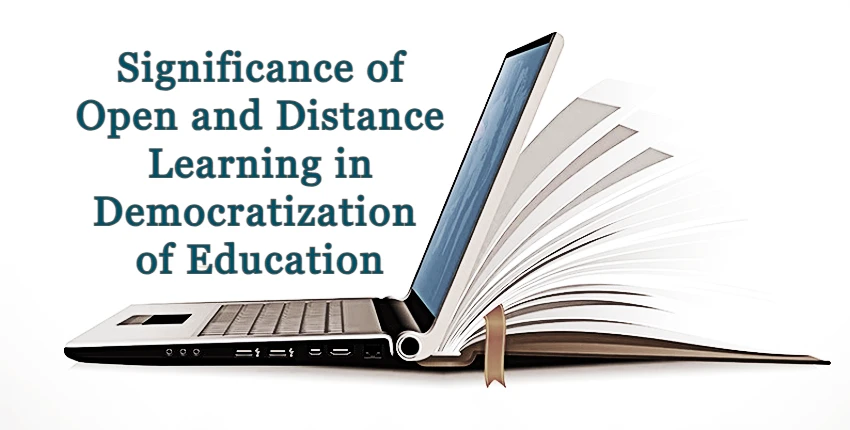Open and distance learning is one of the fastest growing areas of education nowadays and has a significant impact on all education delivery systems. Open and distance learning has great potential to democratize higher education because ODL model focuses on open access to education and training to make learners free from constraints of time and space, and provide flexible learning opportunities for individuals and groups of learners.
In this blog, we will focus attention on the significance of open and distance learning (ODL) in the democratization of education.

Significance of Open and Distance Learning (ODL) in Democratization of Education
The popularity of open and distance learning (ODL) has grown in recent years in various developed, underdeveloped and developing countries, especially to meet the growing needs and aspirations of the people.
The current world scenario is characterized by advances in science, space and technology. Thus, the formal education system fails to introduce significant changes due to its rigidity, and high cost, and the knowledge gained from schools and colleges is obsolete and outdated rather than the latest. Open and distance education can democratize education by providing more flexible pathways, increasing access, and lowering the costs of certification and accreditation.
Massive Open Online Courses (MOOCs) play an important role in providing access to educational content from some of the world’s leading universities to millions of learners across the globe.
The open and distance learning model is used for a variety of purposes. Many methods are used: school radio, interactive radio (IRI), educational television, terrestrial satellite networks, web-based plans, satellites, and multimedia. The ODL is used to educate children and young people who are unable to attend regular schools, including those who have a disability or long-term illness or who live in remote areas or outside their own countries. Certain programs are designed to teach their children lessons that parents can use. The program can also be directed to nomadic backward groups.
One of the advantages of open and distance learning is that it offers flexibility to students who, for reasons of time, geographic location, or economic situation, cannot travel to a higher education institution. Likewise, it favors the development of self-learning -which is a life skill-, and fosters student autonomy as the person responsible for their own learning. In the same way, the use and management of information has no limits, the student deepens his knowledge according to his needs and interests.
With this methodology there is the possibility of devoting much more time to other activities such as work, personal or family activities, with which these activities are balanced with study and a better quality of life is achieved; In addition, you can access resources and learning possibilities through technological tools or pedagogical mediators that you would not otherwise be able to approach.
The United Nations Educational, Scientific and Cultural Organization (UNESCO) initiatives in open and distance learning are based on its general priority of ensuring the right to education for all. While the use of this educational system was supported early by the Organization, new developments in information and ICTs, particularly the Internet and the World Wide Web, have radically increased the demand for lifelong education but also provided new means of meeting the demand.
The emergence of the Internet and related networks such as the World Wide Web has had an increasingly radical impact on the transformation of education and training across all sectors. The impact is already significant in all developed countries, and the vast majority of developing countries despite difficulties and fears seek to participate in the emerging global educational community.
By 1960, the open and distance learning (ODL) framework had developed widely around the world. It was also started in India by some traditional universities.
In 1961, the Education Consultative Board nominated a Correspondence Training Committee chaired by Dr. Daulat Singh Kothari, to introduce the distance learning system. Dr. D. S. Kothari, then the President of the University Grants Commission (UGC) recommended it. In 1962 the first Correspondence School was established. Homework courses were tested as per Indian Education Commission (1964-1966) on the promotion of this system.
Indian educators have enabled the broader field of national development to expand educational frontiers. Thus, in the year 1962 at Delhi University, the idea of starting correspondence education in India was conceived as a pioneering project. The purpose of this project was to make up for lost opportunities in the past or to gain new skills and qualifications for the future. Moreover, educational opportunities are deliberately planned through distance learning to provide people with access to knowledge despite barriers such as geographical distance.
In 1985, when the Union Government adopted a proposal to build an ODL university on behalf of former Prime Minister Indira Gandhi, this framework was strengthened in the mid-1980s. This framework under the central authority of the Open University IGNOU has been doing very well from this point on. Many real challenges arise in realizing the government’s strategy in an agrarian country like India. However, this is also done on an ongoing basis to identify issues and find reasonable arrangements.
There are several traditional colleges in India, and many open universities have been established. The overall student enrollment rate in the open system represents a modest percentage of the total number of students enrolled in higher education. This range will undoubtedly increase. Keeping in mind the importance of joining distance education in India, it was important to look at the experience of this country.
Teacher training is an important area of open and distance learning. There are many examples. The studies, especially from developing countries, demonstrate that distance teacher training can reach a large number of teachers and have a profound impact on the development of national education systems. Therefore, the use of ODL for teacher training is a key strategy if the public education system needs to expand or improve quality. The use of new technologies in the teacher training program is also very appropriate. This trend has been reinforced by the development of new ICTS.
The ODL model is likely to become more accessible and widespread, thus contributing to greater educational equality for people around the globe.





